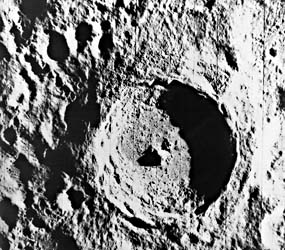 |
|---|
| Plate P-1 |
 |
|---|
| Plate P-1 |
Impact craters are the most common landforms in the solar system, though most people have never seen one on Earth because erosion and deposition have destroyed or covered nearly all the earlier ones. They occur on almost every solid planet and satellite and range in size from "zap pits" a few micrometers wide on returned lunar samples to basins thousands of kilometers rim to rim. In fact, much of the terrain on bodies such as the Moon and Mercury consists of little but craters or crater-related ejecta deposits.
The lunar crater, Tycho, the most obvious feature on the Earthward face of the full Moon because of its spectacular ray system, is easily visible with 7-power binoculars. It is equally conspicuous with Earth-based radar, being highly reflective, and with astronomical measurements of lunar surface temperature during solar eclipses, when Tycho retains its heat far better than its surroundings. Radar and thermal observations before the Lunar Orbiter mission that returned this image indicated that Tycho was probably a relatively young crater, whose anomalous physical properties were the result of exposed solid rock.
| Figure P-1.1 | Figure P-1.2 |
|---|---|
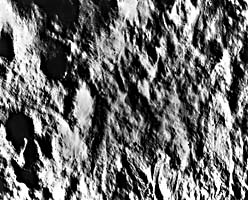 |
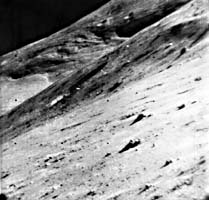 |
The Lunar Orbiter V view in Plate P-1 highlights the terrain of this 85-km wide crater, brought into sharp relief by the morning Sun coming from the right (Lowman, 1969). The crater has a circular raised rim surrounded by a blanket of debris ejected by the impact, an inner terraced wall, an extremely rough floor, and a central peak. These features will be described in order, beginning with the outermost and moving inward. An impact origin for the crater will be assumed here; this assumption will be justified later.
Much material blown out of Tycho during the catastrophic impact that formed it lies far beyond the limits of this image. Judging from the extent of the ray system (partly ejecta and secondary craters formed by ejecta), some material has traveled hundreds of kilometers. The nearer part of the ejecta blanket, shown in Figure P-1.1 (Lunar Orbiter V), appears to be partly solid debris and partly melted or fluidized material produced by the impact. The smooth-floored pond-like features, sometimes called "playas," probably represent the last deposits of impact melt that flowed to low spots in the ejecta blanket. A closeup view of the central part of Figure P-1.1, on the north flank of Tycho, is provided by a Surveyor VII surface picture (Figure P-1.2). Surveyor VII landed just southwest of the conspicuous playa at the center of Figure P-1.1, and the view is to the northeast toward it.
The inner rim and walls of Tycho clearly formed by slumping of material into the initial cavity, presumably only minutes after the impact. They have also in places collected fluidized or liquefied impact debris that flowed toward the floor (Figure P-1.3), as shown by another Lunar Orbiter V view. The crater floor is an extremely rugged terrain, suggesting a giant form of pahoehoe lava. Had this picture been obtained in 1950, many would have interpreted the floor as a solidified lava lake filling a volcanic crater. However, it now seems certain that all large impact craters are initially floored by thick layers of impact melt. An excellent terrestrial analog to Tycho is found in the Manicouagan structure of Quebec. This 65-km wide feature, seen on a Landsat view (Figure P-1.4), appears from its structure and mineralogy to be the eroded remnants of a Triassic impact crater formed in the Grenville Province about 210 million years ago (Glass, 1982). Most of the interior of the Manicouagan structure is a sheet of grossly homogeneous impact melt about 230 m thick. Its mineralogy, bulk chemistry, and strontium isotope ratios confirm that this sheet was formed by shock-melting of the Grenville basement, resulting in a pseudolava with the overall composition of a monzonite. Two hundred million years of erosion, including several glaciation, have smoothed out the floor of the former Manicouagan crater, but initially it must have looked like the floor of Tycho does now. The absolute age of Tycho, incidentally, is probably over 100 Ma. (Taylor, 1982); one estimate from crater statistics is 700 Ma. But the near absence of tectonism and the slow rate of impact erosion have preserved its original morphology.
| Figure P-1.3 | Figure P-1.4 |
|---|---|
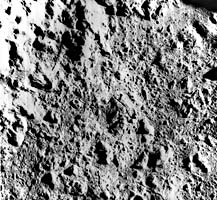 |
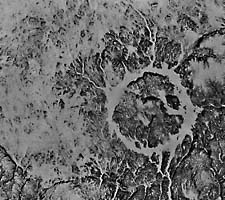 |
The central peak of Tycho, like those of most fresh craters over a few tens of kilometers wide, is morphologically analogous to the central peak of Manicouagan, an uplifted horst of anorthosite. Although the details of central peak formation by impact are not agreed upon, most workers argue for a combination of inward slumping and rebound, resulting in considerable uplift of the target rock. Isostatic adjustment probably plays a minor role in Tycho-like craters, but may become significant in circular mare basins displaying positive gravity anomalies (mascons).
Until the 1960s, many held that craters such as Tycho were lunar volcanoes, specifically calderas (Green, 1971). Now, origin by meteoritic or cometary impact is almost universally accepted, for the following reasons: direct evidence of shock metamorphism in lunar breccias; overwhelming collective evidence for the role of impact in the formation of small lunar craters and the lunar regolith at the six Apollo landing sites; and the existence of scores of comparable terrestrial craters (or their roots) whose impact origin is clearly shown by mineralogical criteria such as high-pressure phases, thetomorphic crystals, and crystallographic features. Finally, sizable asteroids are seen to cross the Earth/Moon orbit fairly frequently (Shoemaker and Helin, 1978). In 3 billion years (the approximate time since lunar internal activity stopped), some such objects must have hit the Moon. If craters such as Tycho are not the scars of such encounters, where are the scars?
The most general objection now to a volcanic origin for Tycho-like craters comes from
planetary missions such as the Mariner, Viking, and Voyager series. These spacecraft have
transmitted pictures of what everyone agrees are extraterrestrial volcanoes, some visibly erupting (on Io). They differ in details and frequently in size from terrestrial examples, but they look like volcanoes-not like Tycho-and were immediately recognized as such. Therefore, the proponents of volcanic origin for lunar craters have in the end won while losing; there are dozens of fascinating extraterrestrial volcanoes for them to study. G-68-2958.
Continue to Plate P-2|
Chapter 10 Table of Contents.|
Return to Home Page|
Complete Table of Contents|